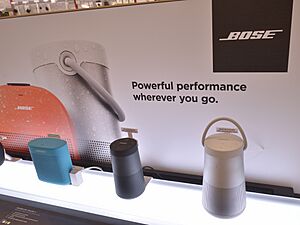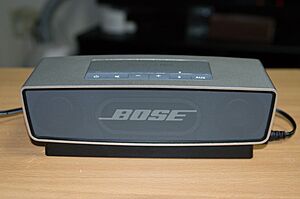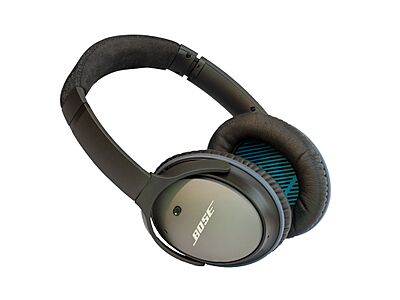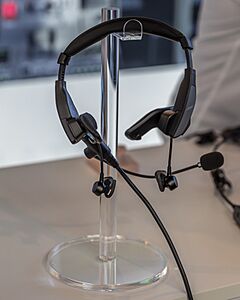Bose Corporation facts for kids
| Private | |
| Industry | Audio electronics |
| Founded | 1964 |
| Founder | Amar Bose |
| Headquarters | Framingham, Massachusetts, U.S. |
|
Key people
|
Lila Snyder, CEO Jim Scammon, President and COO Bob Maresca, Chairman, former CEO |
| Products | Audio equipment |
| Revenue | US$3.2 billion (FY 2021) |
| Owner | Massachusetts Institute of Technology (majority) |
|
Number of employees
|
7,000 (FY 2021) |
Bose Corporation is an American company famous for making high-quality audio equipment. You've probably seen their products, like home speakers, car sound systems, and especially their popular noise-canceling headphones.
The company was started in 1964 by Dr. Amar Bose in Framingham, Massachusetts. Today, most of the company is owned by the Massachusetts Institute of Technology (MIT), a top university where Dr. Bose used to teach. The money MIT receives from Bose helps support the university's research and education.
In 2021, Bose made about $3.2 billion in sales and had around 7,000 employees worldwide.
Contents
How Bose Got Started
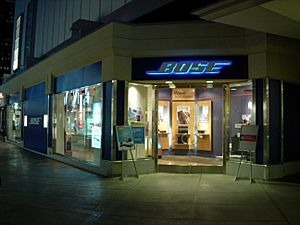
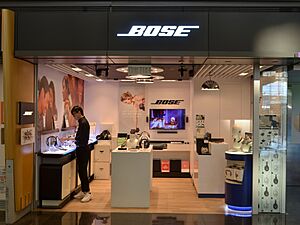
The story of Bose begins with its founder, Amar Bose. In 1956, he bought a new stereo system and was very disappointed with the sound quality. He felt it didn't sound like being at a live concert. This inspired him to create something better.
In 1964, he founded Bose Corporation. His goal was to design speakers that could fill a room with sound, much like a real concert hall. He did this by using multiple speakers that bounced sound off the walls.
The First Speakers
The first product Bose sold was the Bose 2201 in 1966. It was a very unusual speaker with 22 small speakers inside. Many of them faced away from the listener, pointing toward the walls. The idea was to use the room's reflections to make the space sound bigger. However, the 2201 didn't sell well and was discontinued after a few years.
From this experience, Dr. Bose realized that just measuring things like distortion wasn't the best way to judge sound. He believed the most important test was how the audio sounded to a real person.
The Famous 901 Speakers
In 1968, Bose released the Bose 901 stereo speaker system. This design was a huge hit! It had nine speakers. Eight of them pointed at the wall behind the speaker, and only one pointed directly at the listener. This created a rich, spacious sound that people loved.
The 901 was a massive success and helped the company grow very quickly in the 1970s. It was so popular that Bose continued to make and sell it for almost 50 years, until 2016.
Company Growth and Changes
- 1993: The first Bose retail store opened in Kittery, Maine.
- 2011: Amar Bose donated most of the company's shares to his old university, MIT. MIT gets money from Bose every year, but it is not allowed to sell the shares or get involved in running the company.
- 2013: After Amar Bose passed away, Bob Maresca became the new CEO.
- 2020: Bose decided to close its physical retail stores in North America, Europe, Japan, and Australia. The company now focuses on selling its products online and through other stores like Target and Best Buy.
- 2020: Lila Snyder became the company's first female CEO. She is also a graduate of MIT.
Where Bose Products Are Made
Bose products are made in several countries, including the United States, Mexico, China, and Malaysia. The company's main headquarters and some of its factories are in Massachusetts.
Over the years, Bose has updated its manufacturing process. In 2015, it closed factories in South Carolina and Ireland to make its supply chain more efficient. Some of its factories in Mexico and Malaysia are now run by a partner company called Flex, but they continue to produce Bose products.
Popular Bose Products
Bose is known for a wide range of audio gear.
Car Audio
Bose first started putting sound systems directly into cars in 1983, with the Cadillac Seville. Since then, many car brands have offered Bose sound systems as an option.
One of Bose's most interesting projects was an active suspension system for cars. Instead of normal springs, it used powerful magnets to lift the wheels over bumps and potholes, keeping the car perfectly level. A test car was even able to jump over a small obstacle! The system worked, but it was too expensive and heavy to be sold to the public.
Bose also created a special truck seat called Bose Ride. It uses technology to cancel out vibrations from the road, which helps reduce back pain and tiredness for truck drivers.
Home Audio and Video
Bose makes many products for listening to music and watching movies at home. These include:
- Home theater systems
- Portable Bluetooth speakers (like the "SoundLink" series)
- Stereo systems (like the "Wave" systems)
- Computer speakers
- Soundbars for TVs
Headphones
Bose is perhaps most famous for its headphones, especially its noise-canceling models. The company started selling headsets for airplane pilots in 1989 and began making headphones for everyone else in 2000.
Their noise-canceling technology is so good that Bose has contracts to supply special headsets to the U.S. military and NASA.
Sound Systems for Businesses
The Bose Professional division creates sound systems for large public places. They have provided the sound for businesses, concert halls, and even the Winter Olympics in 1988 and 1992.
They also make portable speaker systems for musicians called the Bose L1. These speakers are tall and thin and help spread sound evenly across a stage or room.
Why Bose Doesn't List Tech Specs
You might notice that Bose products don't usually come with a long list of technical numbers, like frequency response. This is on purpose.
Back in 1968, Amar Bose wrote that numbers and measurements don't really tell you how good a speaker sounds. He believed that the best way to judge a product is to listen to it. He once said that measurements can be misleading, and what truly matters is the listener's experience.
Legal History
Like many large companies, Bose has been involved in legal cases to protect its brand and inventions. A company's inventions are protected by patents, and its brand names are protected by trademarks.
- Bose vs. Consumer Reports (1981): The magazine Consumer Reports wrote a review saying the sound from a Bose speaker "tended to wander about the room." Bose sued the magazine, feeling the review was unfair. The case went all the way to the U.S. Supreme Court, which decided that even if the statement wasn't perfectly accurate, it wasn't written with the intent to harm Bose, so it wasn't illegal.
- Protecting Trademarks: Bose has sued other companies to protect its trademarks. For example, it stopped a company from using ".2" in a product name because Bose had a "Model 2.2" speaker. It also protected its "Lifestyle" trademark for home entertainment systems.
- Bose vs. Beats (2014): In 2014, Bose sued Beats Electronics, claiming that Beats used Bose's patented noise-canceling technology in its headphones. At the time, Apple had just bought Beats, making the two companies direct competitors. Bose and Beats eventually settled the case out of court.
See also
 In Spanish: Bose Corporation para niños
In Spanish: Bose Corporation para niños


